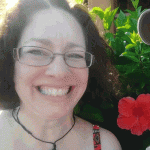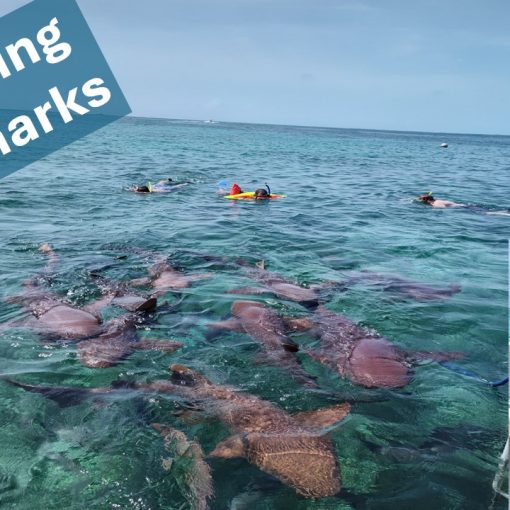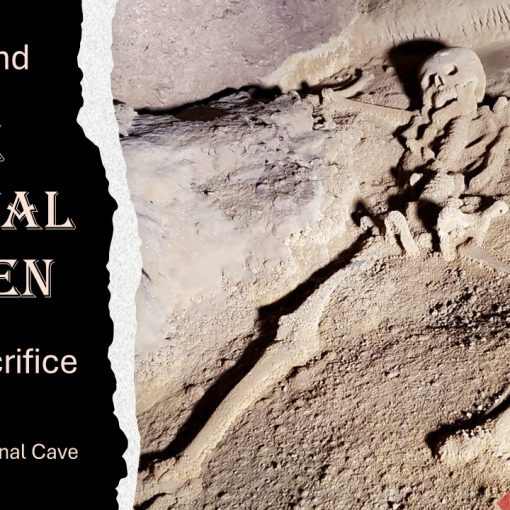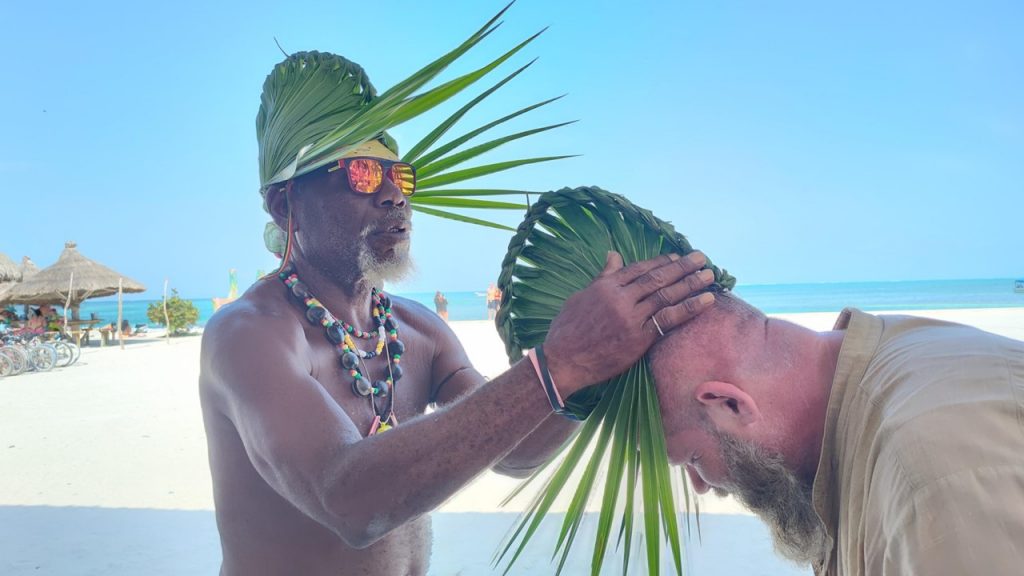
Following this moment, Mondingo returned to his seat on a bench. “How long does it take you to make one of these?” I had asked with interest as the salt water breezes blew through my hair. “Oh, well, I be a professional. There’s no-tellin’.” He answered with a knowing nod. Chuck proudly wore this hat during our week in Belize.
I found the Belizeans to be ingenious and resourceful. Each local we’d met embraced life with a personality full of flavor. Family is their focus! Join us as we travel with guides to and from the island of Ambergris Caye across the country to caves and Maya ruins. Belizean lives are fascinating!
Travel Takes Time
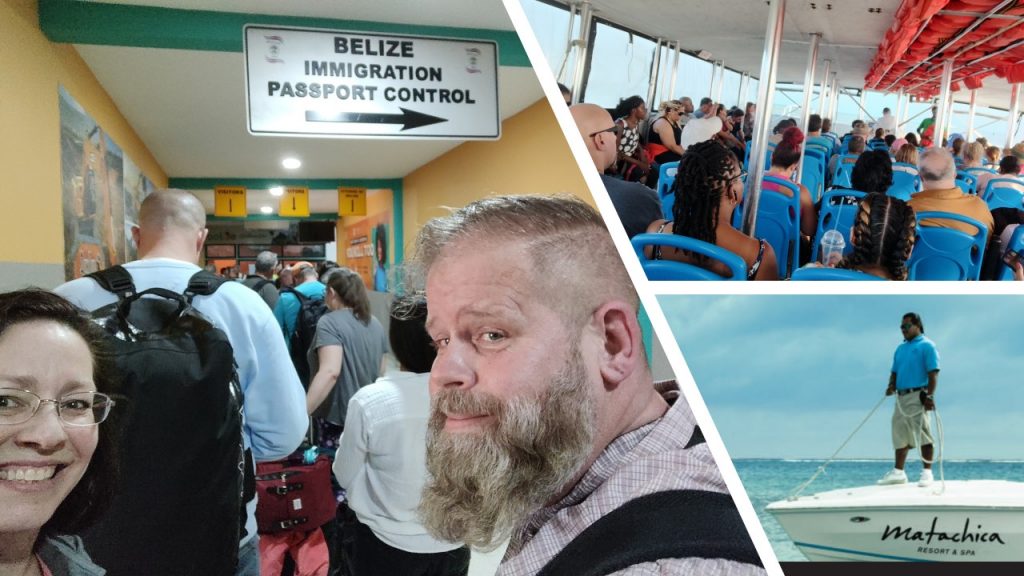
Following airport immigration, we secured a thirty minute ride to the shoreline’s boat taxi.
The boat taxi to the island of Ambergris Caye took ninety minutes.
Then, Charlie from the resort, picked us up for another fifteen minute ride. (bottom right)
Matachica Resort and Spa
Charlie, our Matachica Resort boat captain, takes his whole family fishing on Sundays to catch their food for the week. “What’s your favorite fish?” I asked. “Snapper.” He smiled. “We get many different kinds.” He listed several ocean varieties which I haven’t previously known. As we docked, I reached for my suitcase. “No. No. You’re our guest! I will bring it to your casita.” Charlie smiled.
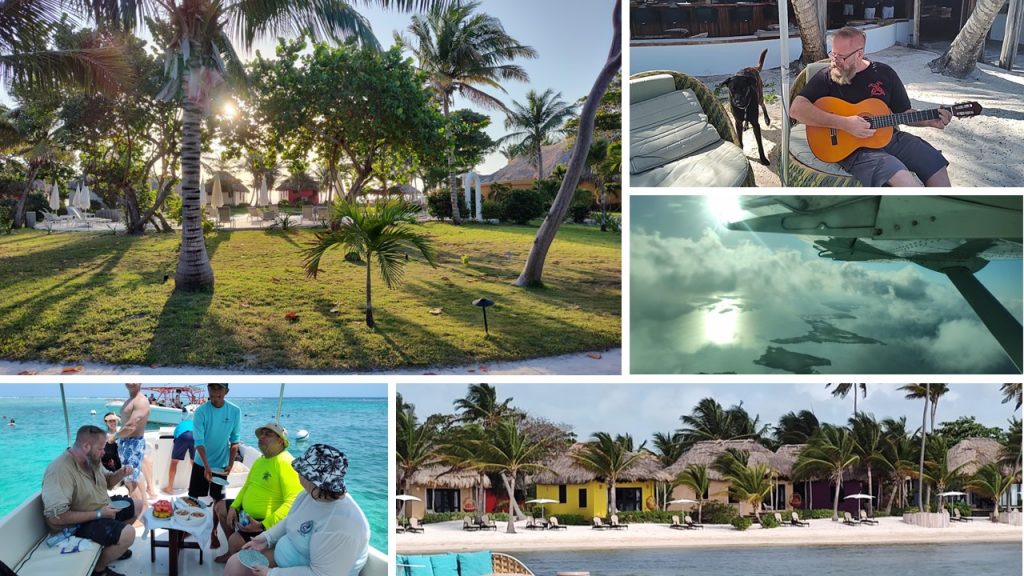
I was transfixed with our view. (top left) There are 32 casitas on the adult-only property.
It was charming and peaceful, but we wanted to ‘experience’ Belize and meet locals, so we rented a golf cart to navigate the island. On two different days we flew back to the mainland for excursions through the villages.
As an English speaking, tropical country, over 9,000 Americans have taken up residence in Belize. Many of these expats are retirees. Each year (pre-pandemic) over two million tourists have made treks to the islands Ambergris Caye and Caye Caulker, 21 miles from the mainland. Currently the visitor numbers have only been around a half a million annually. Chuck and I spent a week exploring this tropical nation. Come along with us!
San Pedro
As we climbed into our rented golf cart, I thought of Madonna’s song, “La Isla Bonita.” She had written the tune after visiting San Pedro. It lilted through my mind as we maneuvered our golf cart five miles south to the city of San Pedro on the island of Ambergris Caye. Golf carts, cars and dump trucks darted around potholes along the same narrow roadway. The boat captain, Charlie, had told us that the road had been built ten years ago. “It’s still quicker to go by boat.” He’d stated. Now I fully understood his comment.
Madonna’s lyrics ‘pretty island’ stood in contrast to the shacks standing alongside four story, newly constructed resorts in various degrees of completion. My brain attempted to process the dissonance of these plots through the filter of zoning laws prevalent in the United States.
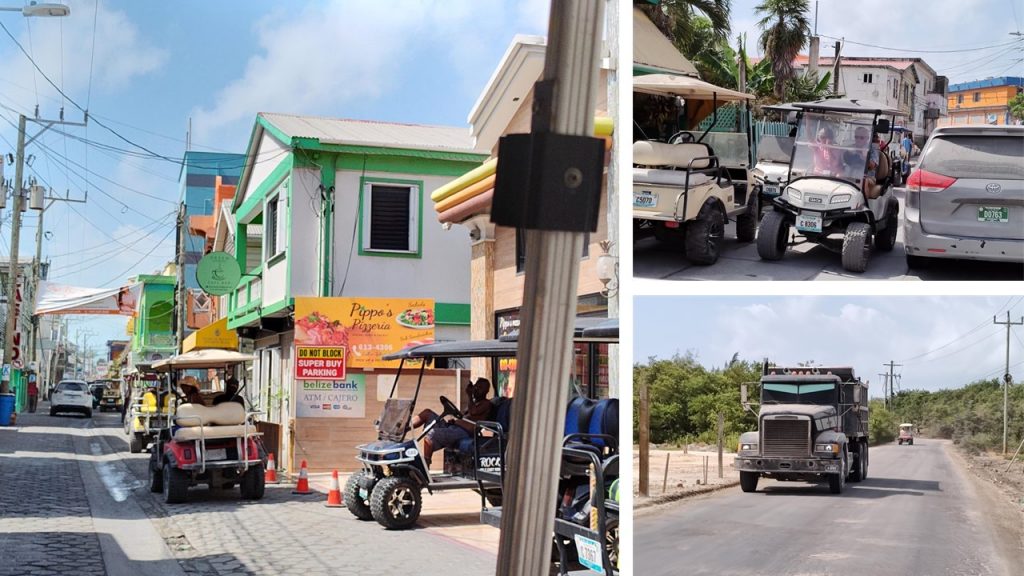
Dustiness and congestion added to my unease as we entered San Pedro. That is until we approached the sandy expanse of the beach. “Last night I dreamt of San Pedro. . . Tropical the island breeze, all of nature wild and free. This is where I long to be. La Isla Bonita.” Madonna’s song rang true. Colorful shops and restaurants huddled in a Caribbean hug. “Quaint” and “Charming” came to mind. Now I could more easily see the song writer’s vision.
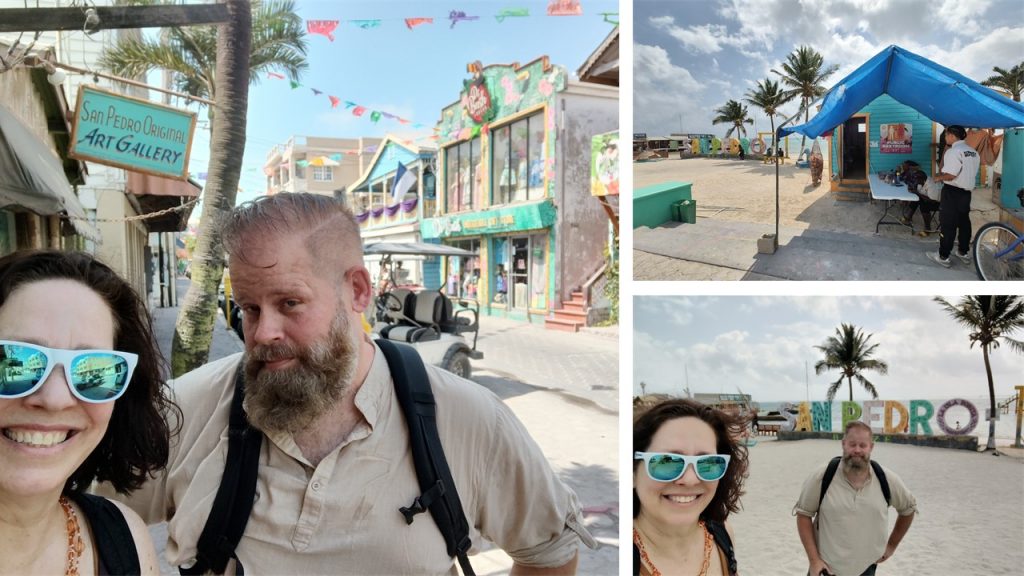
Yes. There’s a security guard standing next to her.
“Yup.” Chuck nodded at the public restroom. “It’s like that all over Central America.” In the early 1990’s Chuck had been to each Central American country, except Belize, through a government travel plan . . . The Army. My husband has always embraced adventure!
Belize History – Highlights
The country of Belize holds a rich history stretched over centuries from the mainland to the surrounding islands called Cayes. The recorded culture of the Maya had settlements and ceremonial areas dotted across the Central American region starting from 1500 BCE – 1200 BCE until about 1000 AD.
In the 1600’s Spanish missionaries and conquistadors came to Central America and harvested “log wood” and mahogany. Soon, the British followed, gaining the wooden riches of the region for construction and textile dyes.
In 1797 the British had ‘relocated’ 5,000 Afro-Caribbean “Garifuna” people to Honduran Bay Island of Roatan. The Garifuna culture still continues today! We met a Garifuna family who taught us about their traditions and food. Stay tuned!
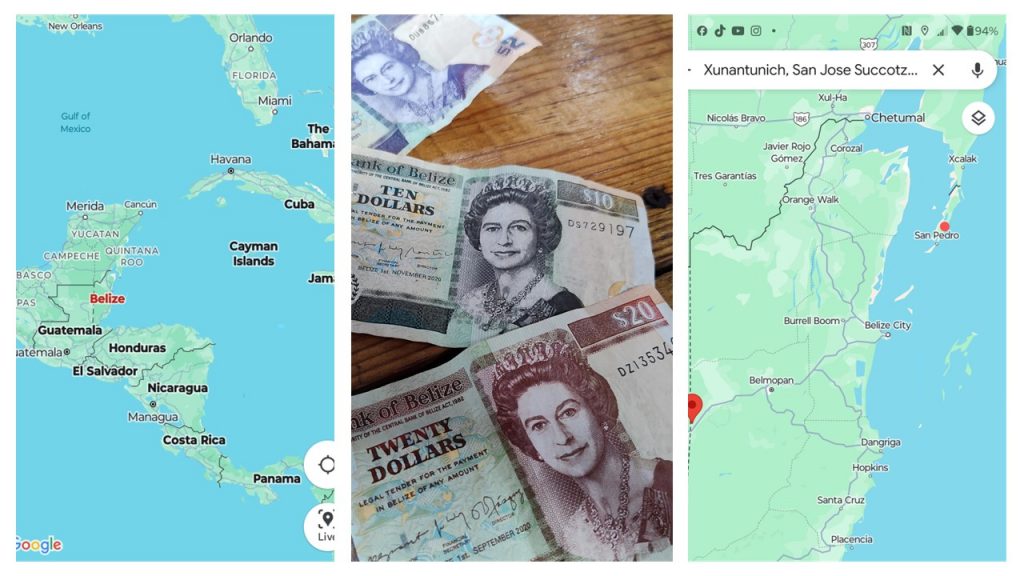
In 1862 the British renamed the area “Colony of British Honduras.” The Garifuna fought against this British control. However, less than a decade later, in 1871, the area had become a British Commonwealth. Today, Belizean money still holds the Queen’s image.
In 1964 the people of this region were allowed to begin governing themselves. The “internal self government” changed their country’s name to “Belize” in 1973. Finally, on September 21, 1981 Belize was granted full independence. Their current Democratic and Republican parties bicker, make promises and shut each other down. But within the political turmoil, each of our guides spoke of caring for their families amid the ‘corruption.’
Maya Ruins – Francisco and Gerson
Both Francisco and Gerson excitedly simmered with a pride and energy about their country’s ancient history, the wildlife and their families.
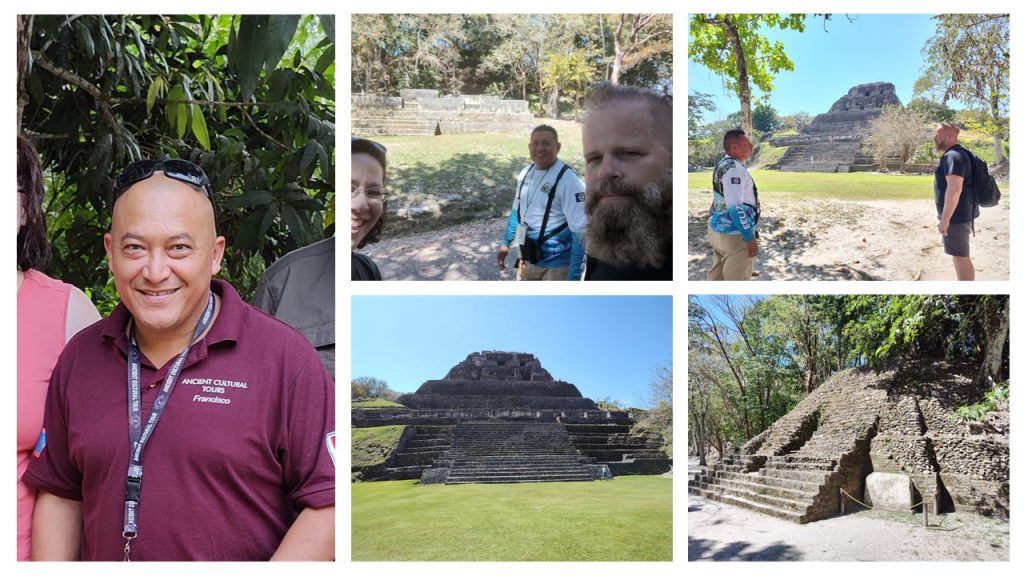
Gerson guided us through Xunantunich, a Maya ruin, zip lining and tubing through a cave.
There’s so much to learn and appreciate in this world! Francisco is one of thirty guides permitted to take a group of eight hiking, swimming and climbing through the Actun Tunichil Muknal (ATM) Cave of the Stone Sepulcher. We hiked through the rainforest, crossing the river three times at the Tapir Mountain Nature Preserve. Then we swam through 12 feet of water into the cave.
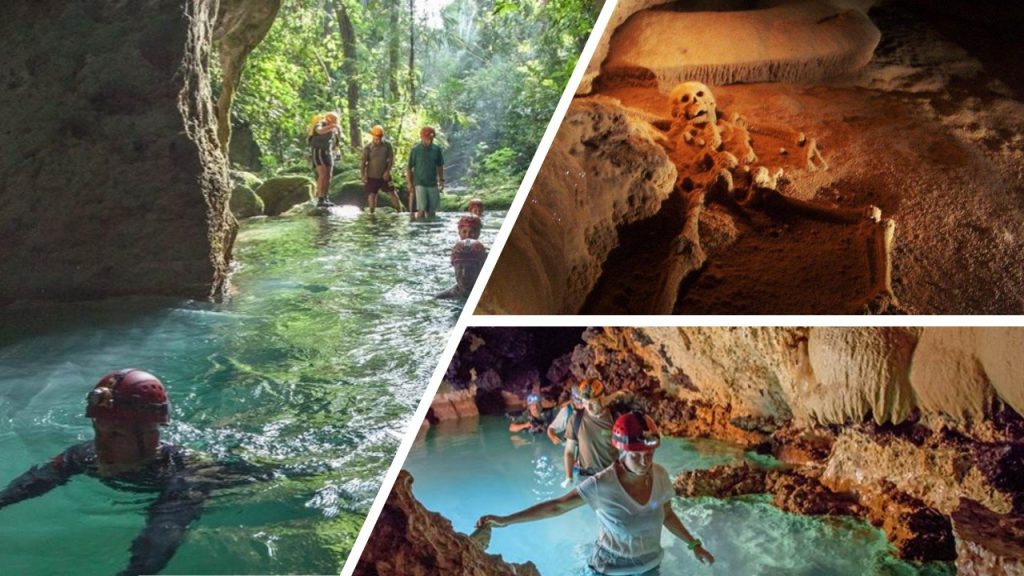
Photo Credit: “Belizing” website and Kim Benedict (bottom right)
After a kilometer of navigating the rocky terrain inside, we climbed into the “cathedral” where centuries ago sacrifices had been made to Chaac, the god of rain, thunder and lightning. It had been an era of drought and the community had been desperate. Four skulls were visible in the cathedral area. Cameras, however, were no longer allowed. There are 1,400 visible artifacts throughout this cave including “The Crystal Maiden,” a full skeleton glazed in sparkling limestone. National Geographic has this cave ranked as one of the top ten in the world. I felt like Indiana Jones! It was an honor to be able to be witness to these relics.
Another day we’d toured Xunantunich, a Maya ruin, with Gerson. There’s so much he taught us, but the memories that stand out are the times Gerson pointed out wildlife. As we rode across Belize on their two lane highway complete with traffic circles, speed bumps and police check points. (Checking for insurance stickers on their windshield.) Gerson suddenly flipped on his left blinker. I only saw a swamp to the left. ‘Where was he turning?’ I questioned silently with my eyebrow from the backseat. When the traffic cleared he steered across the roadway and pulled onto the narrow, grassy shoulder. He had pointed out white birds with long bills. It was a flock of ibis securing snacks from the watery muck. I was too distracted by the oncoming traffic to take any photos.
At the ruins he plucked a long piece of grass and danced it into a quiet hole surrounded by short grass. This time I just had to ask. “You’ll see.” He threaded the stalk farther into the opening. Suddenly two hairy, black legs appeared and quickly retracted. “Awww. He won’t come out. They just mowed the grass.” He shrugged. Well, I was “OK” with the tarantula’s decision to remain hidden. The rest of the hike I kept an eerie eye out for holes in the ground!
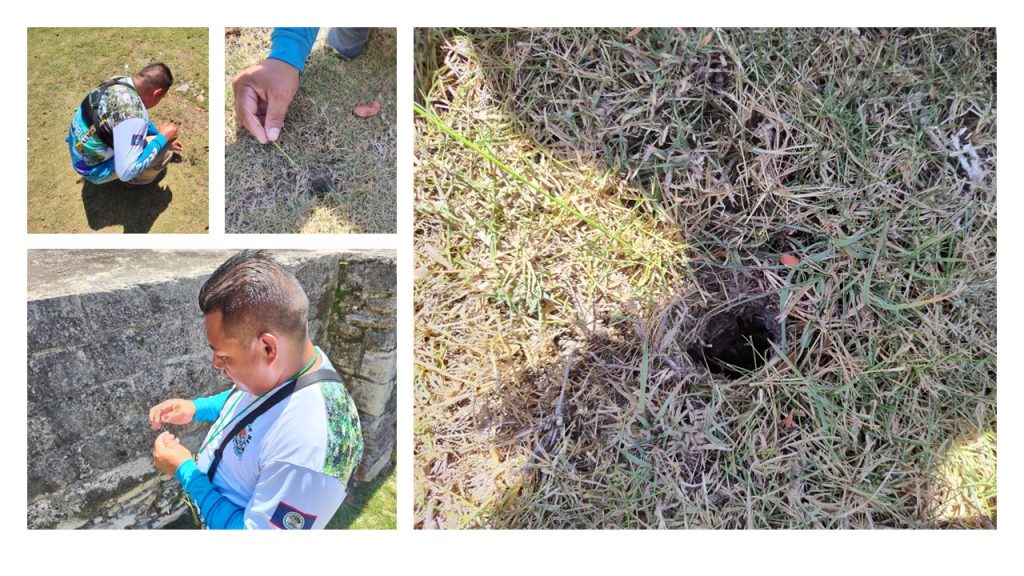
At the next stop Gerson suited us with innertubes and hard hats, complete with a headlamps. He guided us through the No’hoch Che’en national park cave. At one point we emerged into the sunlight. Gerson pointed to a rustle in the tree tops. “Humph! Eeeee! Humph!” he called loudly toward the foliage.
I squeezed Chuck’s foot, which was resting on my tube. I couldn’t turn and share a look, so I had grabbed the nearest part of Chuck as a silent connection, enjoying Gerson’s passion. Our guide whispered to us, “It’s a howler monkey.” He pointed. “Do you see him?” The mammal quickly moved a branch, taking cover from behind lush leaves.
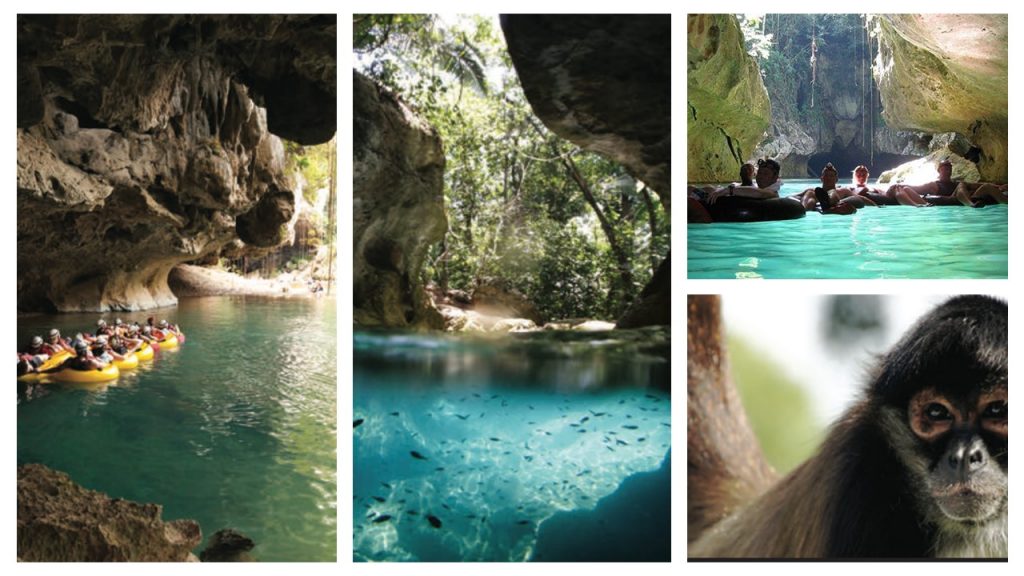
Photo Credit: Belizean Adventures website
Jason’s Positive Outlook
Colorful clothing flapped in the breeze as we rode with Jason across Belize heading to another adventure. Jason spoke so freely. There were no walls around his words. He painted a picture of life in Belize with his descriptions of his experience.
“When my wife was pregnant for our third child, I bought sheep, goats and chickens from a Mennonite. With YouTube, we learned how to care for and slaughter the animals.” He stated matter-of-factly. “Then, when the pandemic hit, we were able to supply our village with fresh meat and eggs.” His resourcefulness impressed me, but I wondered how his pregnant wife had felt about suddenly having a small farm. “Oh, she’d always wanted a farm.” Jason smiled. “But that’s all history now.” With his job as tour guide, he’s not home enough to care for the brood of livestock.
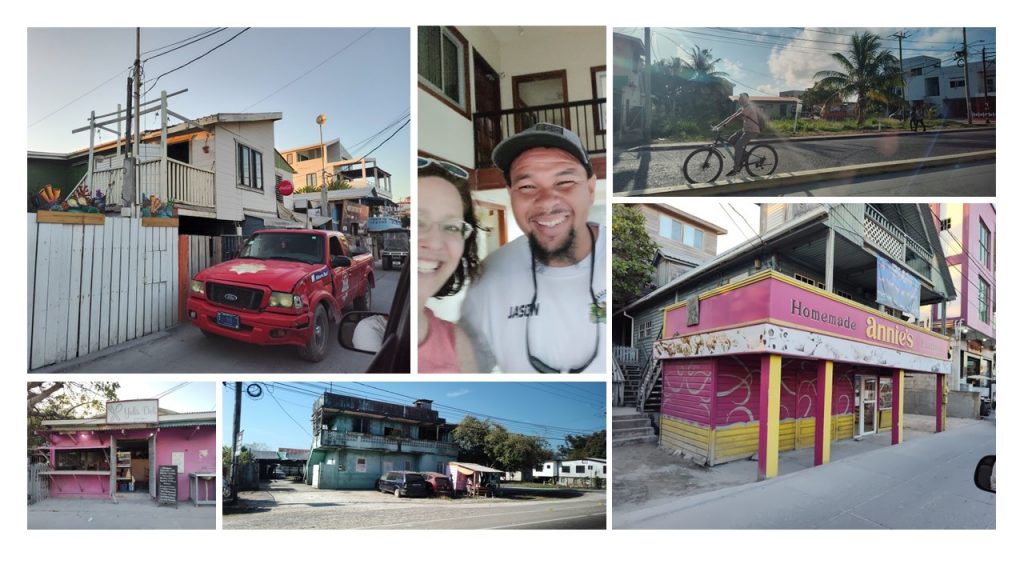
as he drove us across the country. He taught us about life in Belize.
“Yup. You’ve got to have money for medical treatment.” He shared openly. “My mom had cancer, but the chemotherapy was only in Guatemala and Mexico. It would cost thousands.” He shrugged. “That’s how life goes sometimes.” We offered our condolences. He was quiet as we navigated over speed bumps and through a traffic circle as we neared a village. “Now I have my two sisters living with us, too.”
Children dressed in yellow shirts and brown pants (boys) and brown jumpers (girls) skipped along the roadside. “Kids start walking to school as soon as they know the way. They’re independent here.” Jason nodded knowingly. I asked, “So, parents have to buy the uniforms?” “Oh, yes. Parents pay for the books and tuition, too.” Jason explained. “There’s buses that go into Guatemala each fall, so parents can purchase the clothes cheaper. They are made in Guatemala.” Jason continued. “Education is important. We want our kids to have a better life. But there are no loans, families have to save up. Now I have six kids to be responsible for.” (His three sons, one daughter plus his two teenage sisters.) I commented how that must be hard. “Well, it’s what I have to do.”
“To become a tour guide, you have to take seven tests.” Jason explained. “This is a good job, being an ambassador for our country.”
“There’s a lot of Mennonite and Amish who live down here.” Jason commented as we passed a buggy. (pictured below) They provide a lot of our food, but more recently, they’ve been hauling cocaine hidden under their fruit.” He shook his head. “Everyone’s gotta find a way to make money, I guess.” We wondered if they get caught. “Some do, but others get away with it.” He shrugged.
Mennonite Drug Running
The following day while sitting at an outdoor bar on the island of Caye Caulker, I engaged a “Tourist Police” officer asking about his job. Cruise ships and resorts send hundreds of people to Caye Caulker daily. “I have to make sure everyone gets back on their boats.” the officer lilted his head toward the dock. Chuck bravely commented, “So I heard that some Mennonites have been running drugs.”
“Yes!” replied the officer removing his sunglasses for a moment. “The drugs come up from South America. They land the planes in the Mennonite fields. Then the product gets brought north to Mexico.” He nodded with confirmation.
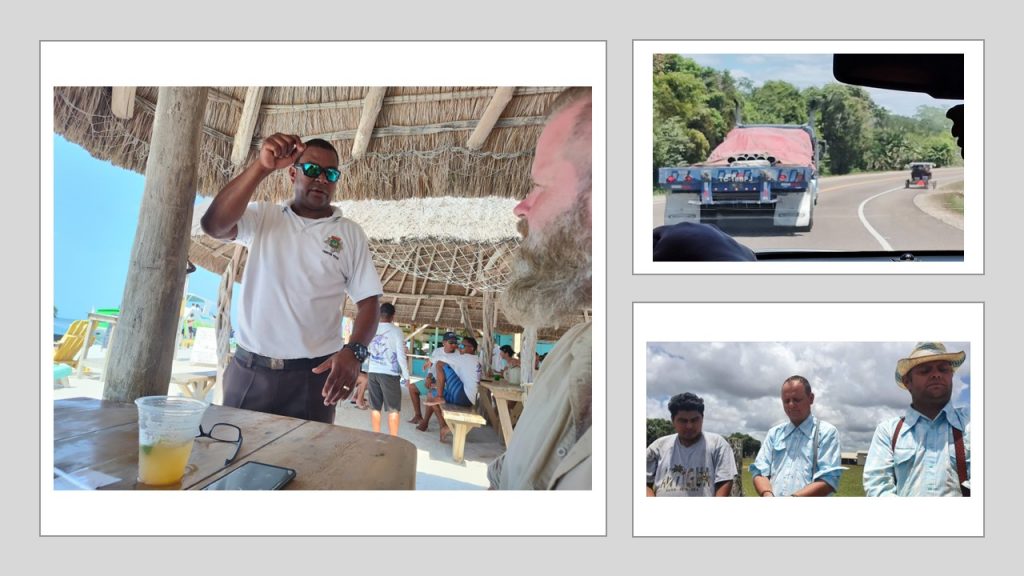
transporting kilos of cocaine hidden under their produce.
(Bottom Right) Eric Barrera had been giving a ride to Cornelius and John Reddecopp, Mennonite farmers, when they were caught in 2022. Photo credit: Belize News 7
I’d been stunned by this disclosure. Ultra religious people transporting drugs! But there’s a variety of personalities in every walk of life. It’s unsettling and eye opening!
Garifuna Culture
Remember how I’d mentioned the Garifuna culture? Well, south of San Pedro we entered the Black and White Garifuna Restaurant and Cultural Center by passing around a half-wall of corrugated steel to an outdoor bar and tables. Across the sandy-floor seating area sat drums on a platform. These instruments have been used for centuries to tell tales of love, loss, joy and triumphs. I wondered if they’d be played while we were there.
We ordered our drinks and food. Chuck ordered “Darasa.” It had a pig tail, barracuda fish and stewed vegetables. I chose “hudut.” (bottom right) Fried fish added to coconut sauce. Rice and plantains were served on the side.
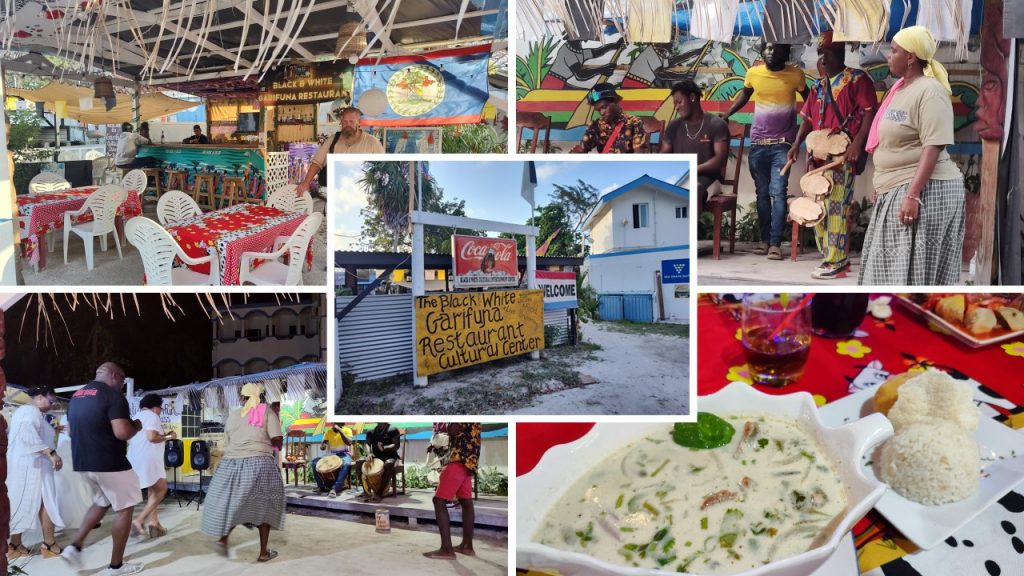
provided traditional food, drumming and dance lessons.
As we finished our meal, the family emerged onto the stage. The steamy air was punctuated with drum beats. SubaCity, the father, invited me up to beat the sacred drum. I was honored and attempted to follow his example. When I wasn’t very proficient, his wife invited me to dance with her and another guest. She taught us “Paranda,” where one steps forward then back. (bottom left). Next, she taught us a hip wiggling step called, “Punta.” She instructed us, then said, “You do this one alone.” SubaCity nodded to his band of sons and his friend, David. They started playing. With slightly bent knees I made a spectacle of myself and loved every moment! The drum beats were dressed in African colors and filled the neighborhood. As I danced sand crept into my sandals and settled between my toes. I felt transported to the African plains.
“We are the only group who has a flag.” our hostess explained. “It’s Black, White and Yellow. Da black is for African heritage, da white says peace and da yellow is for hope.” With over 300 countries in the world, each having their own flag, it is special that the Garifuna have their own banner of tradition without having boarders in the sand.
As the drum beats sent the sun to bed, more people began to gather. We stayed and watched the next group receive dance instructions. When they were ready to order their meals, we took our leave. It had been powerful to be absorbed in the Garifuna energy!
Confident Children
The youngsters on the island were confident with conversations and free to explore. This reminded me of Maria Montessori’s teachings about letting children lead their learning. It was refreshing to see kids enjoying nature and investigating their world. This tiny crab got a lot of practice holding on by one claw as it was repeatedly relocated by the threesome.
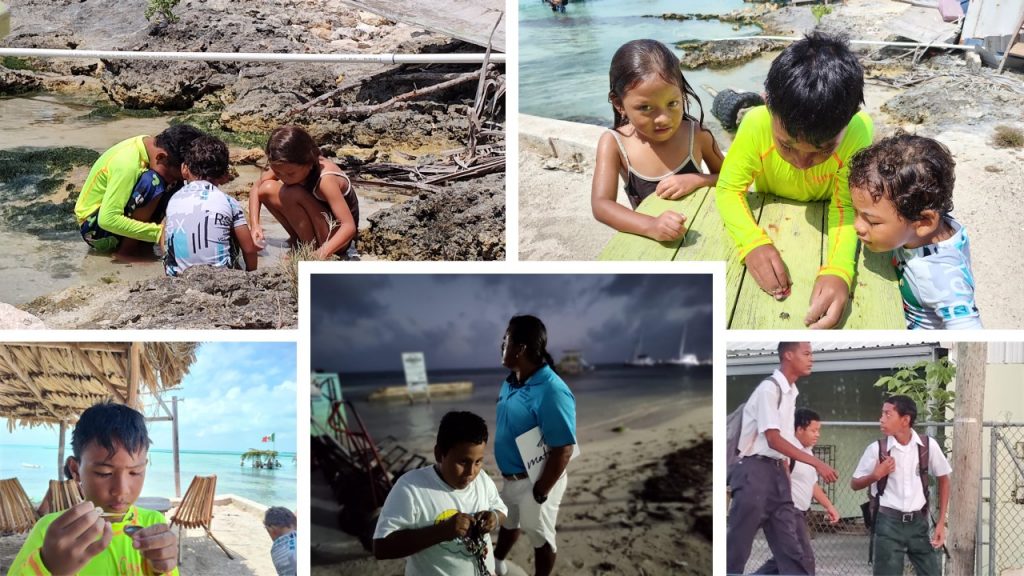
But living with Chuck and teaching elementary school, I didn’t jump as Zane had hoped.
That had been his opening for his sales pitch to sell me bracelets. It still worked!
DaVince (yellow shirt) and his cousins showed us a tiny crab that they’d found.
Nine year old, DaVince, asked us, “Ya wanna know the tricky thing about me?” We nodded, “Sure.”
“Well, I am failing English, but I talk English. I only know three words in Spanish, but I’m passing Spanish.” He shook his head at his own revelation. These cousins spent thirty minutes chatting with us as we sipped pina coladas at Aurora’s Bar near Secret Beach.
Reflections
The Belizeans we’d met have inspired me to remain focused on our family and community no matter how frustrated I become with our world. Now I hold a whole new appreciation for our public schools, healthcare system as well as our infrastructure. I know these systems can use improvements, but I am thankful for what we have in this country. The Belizean’s pride in their culture was woven through every moment of their day. I plan to embrace moments and soak them up with every sense. Thank you for joining us in Belize!
Related Links:
“Swimming with Sharks” Restless Viking article
Restless Viking merchandise is now available!
Resources:
Guides: Francisco, Gerson and Jason
Trees of Belize article
Matachica Resort website
Belizing Travel website
Belize Cave Tubing website of Belizean Adventures
7 News Belize Facebook Page 2022

